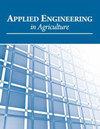Research on Recognition Method of Chinese Cabbage Growth Periods Based on Swin Transformer and Transfer Learning
IF 0.9
4区 农林科学
Q4 AGRICULTURAL ENGINEERING
引用次数: 0
Abstract
Highlights To the best of our knowledge, this study was the first intelligent recognition for Chinese cabbage growth period and proposed the Swin Transformer+1 model. If the four growth periods were considered, the recognition accuracy rate of the model on the test set was 96.15%. If the transition periods of Chinese cabbage growth were considered, the model recognition accuracy rate was 97.17%. Experiments showed that the Swin Transformer+1 model was robust and could be applied in real agricultural production. Abstract. In order to facilitate agricultural management and improve the quality and yield of Chinese cabbage, it is necessary to intelligently identify the growth periods of Chinese cabbage. In this study, a transfer learning-based recognition model for Chinese cabbage growth periods was proposed, which could identify four growth periods of Chinese cabbage: “germination and seedling period,” “rosette period,” “heading period,” and “dormant period.” The data set of Chinese cabbage growth periods was built. The recognition model was named Swin Transformer+1, using Swin Transformer as the backbone network to extract image features, and a fully connected layer as the classifier. To optimize the model, we used Letterbox instead of Stretching to resize the image, used Focal Loss instead of Cross Entropy Loss as the loss function, and used Stochastic Weight Averaging instead of Adam as the optimizer. Transfer learning was used for training, which could solve the problems of overfitting and underfitting when training deep network with a small data set. We verified the effectiveness of the above improved methods through ablation experiments. Experiments showed that the Swin Transformer+1 model had a high recognition accuracy rate. If only the four growth periods were considered, the recognition accuracy rate was 96.15%. If the transition periods between two growth periods of Chinese cabbage were considered, the recognition accuracy rate was 97.17%. The model had strong robustness. It maintained a high recognition accuracy rate when the images in the test set were augmented. In general, Swin Transformer+1 model has high application value in actual agricultural production scenarios. Keywords: Chinese cabbage growth period, Deep learning, Image recognition, Swin transformer, Transfer learning基于Swin变压器和迁移学习的大白菜生育期识别方法研究
据我们所知,本研究首次对大白菜生长期进行智能识别,并提出了Swin Transformer+1模型。如果考虑四个生长期,模型在测试集上的识别准确率为96.15%。考虑大白菜生长的过渡期,模型识别准确率为97.17%。实验表明,Swin Transformer+1模型具有较强的鲁棒性,可应用于实际农业生产。摘要为了便于农业管理,提高大白菜的品质和产量,有必要对大白菜的生长期进行智能识别。本研究提出了一种基于迁移学习的大白菜生育期识别模型,该模型可以识别大白菜的“发苗期”、“莲座期”、“抽穗期”和“休眠期”四个生育期。建立了大白菜生育期数据集。该识别模型命名为Swin Transformer+1,使用Swin Transformer作为主干网络提取图像特征,使用全连通层作为分类器。为了优化模型,我们使用Letterbox而不是Stretching来调整图像大小,使用Focal Loss而不是Cross Entropy Loss作为损失函数,使用Stochastic Weight Averaging而不是Adam作为优化器。采用迁移学习进行训练,可以解决小数据集训练深度网络时的过拟合和欠拟合问题。通过烧蚀实验验证了上述改进方法的有效性。实验表明,Swin Transformer+1模型具有较高的识别准确率。如果只考虑四个生长期,识别准确率为96.15%。考虑大白菜两个生育期之间的过渡时期,识别准确率为97.17%。模型具有较强的鲁棒性。在对测试集中的图像进行增强时,仍能保持较高的识别准确率。总体而言,Swin Transformer+1模型在实际农业生产场景中具有较高的应用价值。关键词:大白菜生长期,深度学习,图像识别,Swin变压器,迁移学习
本文章由计算机程序翻译,如有差异,请以英文原文为准。
求助全文
约1分钟内获得全文
求助全文
来源期刊

Applied Engineering in Agriculture
农林科学-农业工程
CiteScore
1.80
自引率
11.10%
发文量
69
审稿时长
6 months
期刊介绍:
This peer-reviewed journal publishes applications of engineering and technology research that address agricultural, food, and biological systems problems. Submissions must include results of practical experiences, tests, or trials presented in a manner and style that will allow easy adaptation by others; results of reviews or studies of installations or applications with substantially new or significant information not readily available in other refereed publications; or a description of successful methods of techniques of education, outreach, or technology transfer.
 求助内容:
求助内容: 应助结果提醒方式:
应助结果提醒方式:


